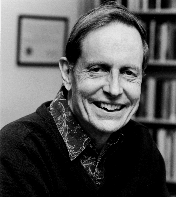Paul Garabedian

Paul Garabedian died on Thursday, May 13th, 2010 at his home in Manhattan. He was 82 years old.
Paul was one of the outstanding mathematicians of his time. As a pure mathematician, he made fundamental contributions to the theory of partial differential equations and to the theory of functions of a complex variable. As an applied mathematician, his astonishing calculation of shockless airfoils has had a major impact on modern aircraft design, and his studies of plasma stability are central to the problem of designing fusion reactors.
While growing up in an academic family, Paul did not attend school until it was time to go to college. He did his undergraduate studies at Brown, after which he attended Harvard for his graduate degrees, receiving a PhD in 1948 under Lars Valerian Ahlfors, on the subject of “Schwarz’s Lemma and the Szegö Kernel Functions.” He subsequently spent one year teaching at the University of California, Berkeley and nine years at Stanford.
Paul joined NYU’s Courant Institute in 1959, and was a member of the faculty for fifty-one years. A few years after his arrival at Courant, Paul published his first book, Partial Differential Equations (1964), which continues to be used worldwide. He advised twenty-seven PhD students (all but four at Courant), and was the Director of the Division of Computational Fluid Dynamics at Courant for 32 years (1978-2010). Of the Institute, he said: “My gosh this is a place with lots of strange people around … but I feel very comfortable here, so I must be one of them.”
During the 1950s, Paul was a pioneer in the use of computing to solve important scientific and engineering problems. He showed, for example, that proper shielding would permit high altitude vehicles (including intercontinental ballistic missiles) to reenter the atmosphere without burning up. During the 1960s and 1970s, Paul and his students and coworkers developed codes to study supercritical wing technology because of the development of aircraft designed to fly near the speed of sound. The basic principle involved concerns the suppression of boundary layer separation by shifting shock waves that occur on the wing toward the trailing edge and making the shock waves as weak as possible. The mathematical technique he used was so sophisticated that, for a time, it was ignored by the aeronautics community. When finally tested, however, it revolutionized the industry. The resulting wing increases lift, fuel efficiency and the speed of aircraft, and the ideas that flowed from this work influence much of commercial aircraft design today. A NASA Award and a NASA Certificate of Recognition acknowledged this research, which resulted in three books with longtime collaborator Frances Bauer (whom he met during his undergraduate studies at Brown, while she was a graduate student), former PhD student David Korn, and Antony Jameson.
Paul started working on problems related to fusion energy in the 1970s – a potential method for power generation that is carbon-free and would avoid the possibility of nuclear accidents and the problem of nuclear waste storage. One of the difficulties in making the technology practical concerns the need to confine an ionized gas (a plasma), and one of the main methods for doing this involves controlling the gas with magnetic fields. Paul used the techniques he had developed for problems in classical fluid dynamics and extended them to study this magnetic confinement problem, first working on free boundary models to understand plasma physics experiments carried out at Los Alamos National Laboratory and the Max-Planck Institute for Plasma Physics in Germany. Over the years, the sophistication of the plasma modeling tools in Paul’s research group grew, resulting in the NSTAB suite of computer codes which are used to study plasma equilibrium, transport, and stability. Paul’s ideas have played an important role in the theory underlying fusion reactor design. In characteristic fashion, he was vocal in describing what he saw as flaws in tokamak systems, such as the International Thermonuclear Experimental Reactor (ITER) currently under construction in France. Equally characteristic, he proposed alternatives to follow ITER that might be able to resolve those same problems.
Paul was actively pursuing his research up until his death, publishing one paper each in 2009 and 2010 with former PhD student & collaborator Jeff McFadden (now at NIST). In a 2005 SIAM oral interview, Paul remarked to Philip Davis: “I was a child prodigy. I still am a child prodigy, but there are very few people who know that.”
Among his many honors, Paul received the Birkhoff Prize (awarded by the American Mathematical Society (AMS) and the Society for Industrial and Applied Mathematics (SIAM)) for an outstanding contribution to "applied mathematics in the highest and broadest sense,” the Theodore von Karman Prize awarded by SIAM, the National Academy of Sciences Award in Applied Mathematics and Numerical Analysis, and the Boris Pregal Award from the New York Academy of Sciences. He was a member of the National Academy of Sciences, the American Academy of Arts & Sciences, and a fellow of SIAM and the American Physical Society. Although only one quarter Armenian, he was proud of his heritage, and a hero to the Armenian mathematical community. A scientific conference in his honor will be held at the Courant Institute during the 2010-2011 academic year.
Paul is survived by his wife, Lynnel; daughters, Emily and Cathy; and two grandchildren.
